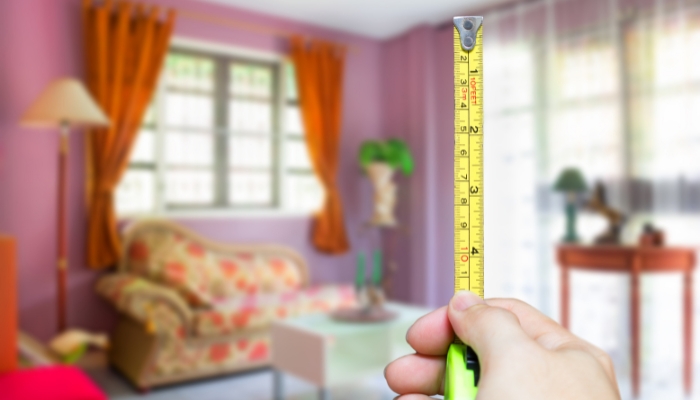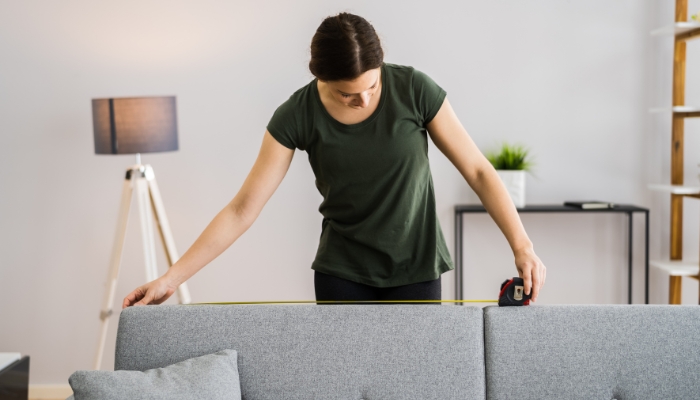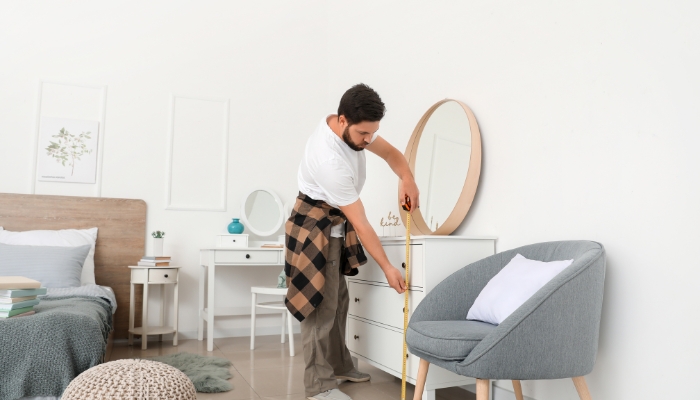Measuring for décor success
Carpenters say it all the time, “measure twice, cut once”. Well, the same goes for décor measurements, “measure twice, design once”. If you don’t measure, the likelihood of having to redesign a space (or live with your painful mistake!) is very great.

A coffee table that always assaults your chins, side tables three feet below your bed, a sofa that won’t fit through the door: these are all avoidable by measuring your room and furniture properly.
The first thing to know is when it comes to bedroom furniture, living room and dining room furniture, office furniture, and furniture for the rest of the house, there are standard sizes for almost all it.

Living Room Furniture:
- Three-seat sofa: 38-inches deep by 90-inches wide
- Two-Seat or Condo Sofa: 38-inches deep by 68-inches wide
- Loveseat: 38-inches deep by 60-inches wide
- Armchair: 35-inches deep by 35-inches wide
- Coffee Table: 48-inches long by 30-inches wide
- Square end table: 24-inches long by 24-inches wide
- Rectangular end table: 28-inches long by 25-inches wide
- Four-shelf bookcase: 54-inches tall by 45-inches wide
Dining Room Furniture:
- Dining table (regular): 72-inches long by 36-inches wide
- Round table (four people): From a 36-inch diameter to a 44-inch diameter
- Dining Room Benches: Standard is between 48 and 60-inches
- Side chair: 18-inches deep by 18-inches wide
- Armchair: 18-inches deep by 22-inches wide

Bedroom Furniture:
- Twin bed: 39-inches wide by 80-inches long
- Day Bed: 39-inches wide by 75-inches long
- Double or full bed: 54-inches wide by 80-inches long
- Queen bed: 60-inches wide by 80-inches long
- King bed: 76-inches wide by 80-inches long
- California king bed: 72-inches wide by 84-inches long
- Standard chest of drawers: 30-inches wide by 18-inches deep
- Nightstand: 18-inches wide by 18-inches deep
Most homes and apartments have standard sizes too, like door frames and windows. While it’s important to know there are standard sizes, we always recommend measuring regardless.
Measuring your space
When it comes to measuring your space for incoming furniture, you will want to be sure you measure all entries and passageways (both width and height). You will need to assess stairways and doorways your furniture may need to travel through. Will the furniture require sharp turns in halls or on stairs? Another factor to consider is any light fixtures, artwork, or other details that can’t be moved and may impede furniture coming in.
Measuring your furniture
If you are looking to replace an existing piece of furniture with something new, be sure to measure it and take those dimensions with you shopping.
Here’s our handy guide for measuring your furniture:
Width:
When facing the front of the furniture item, the width is measured from the outer edges of each side. This measurement helps determine how much space the furniture will take up in the room, and how much clearance a piece will need anytime it's being moved in a straight line (like down your hallway).
Depth:
When facing the side or profile of a furniture item, the depth is measured from the furthest front edge to the furthest back edge. If furniture has an angled back, measure from the widest point of the angle for the most accurate measurement. This measurement will help you figure out how far a piece will sit from the wall, and if it will fit through doorways, hallways, stairwells, etc.
Height:
When facing the side or profile of your furniture item, the height is measured from the bottom where it meets to floor to the highest point of the item. Some furniture will have removable legs or cushions to make them smaller for delivery. When you are measuring your space, be sure to note the difference between the assembled in room size and the delivery dimensions. This measurement will help you figure out how tall your furniture item will be fully assembled, and if it will fit through doorways, hallways, stairwells, etc.
Diagonal Width:
The diagonal width is measured between opposite corners, this dimension is longer than the overall width of a piece of furniture. Diagonal width is important anytime a large piece of furniture needs to be stood up on end to pivot around a tight corner or move through a stairwell, elevator, doorway etc. We don’t want to be Ross and not be able to PIVOT!

Need inspiration?
If your room is a blank slate and you are trying to work out layout and design, it’s helpful to lay painters tape on the floors to map out sofas and coffee tables, and how a space will ‘feel’ with new items inside.
View our complete online catalogue to begin dreaming up your new space and marking out where things will go. Have questions? Be sure to visit us in store and speak with one of our experts.
